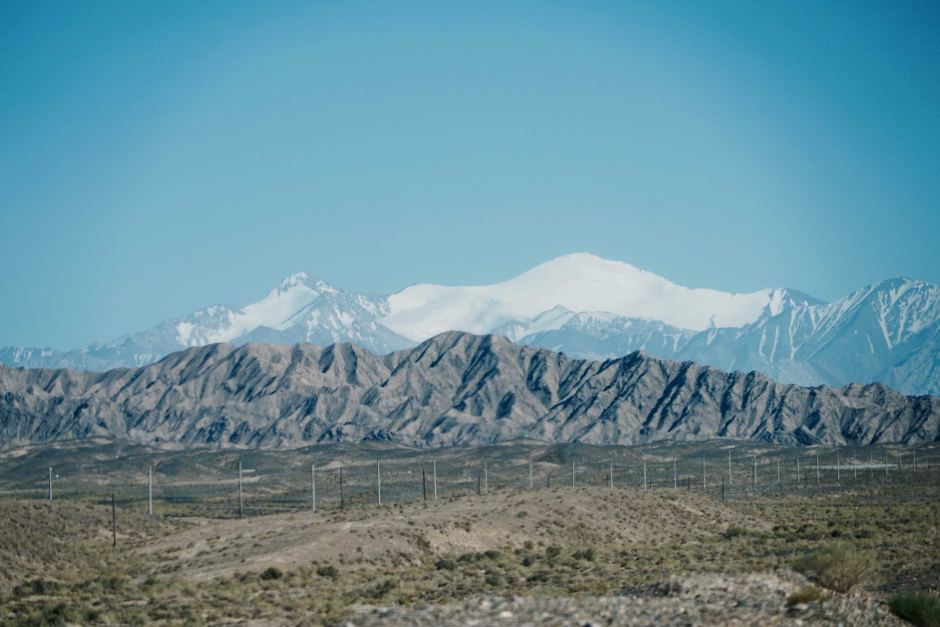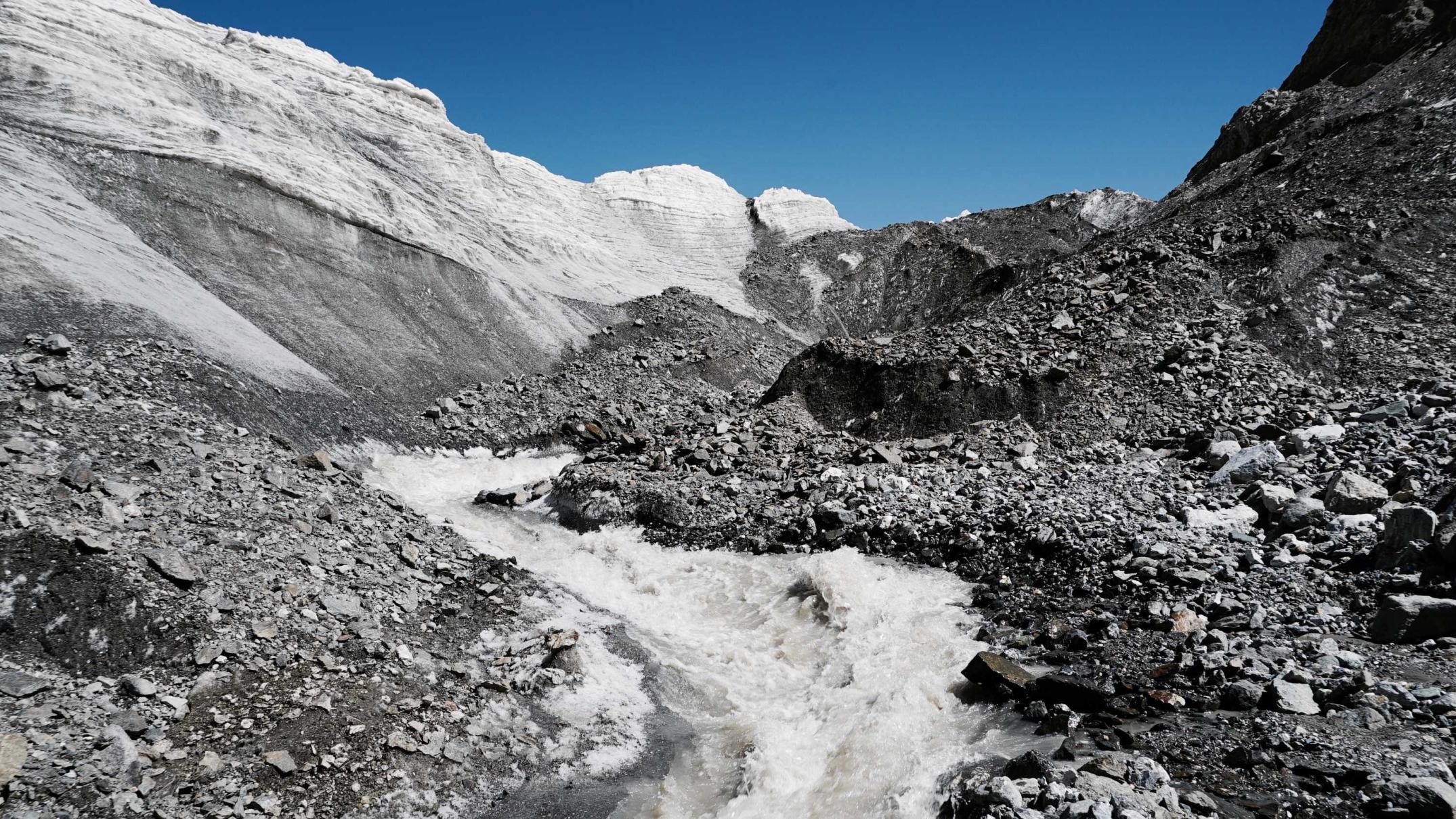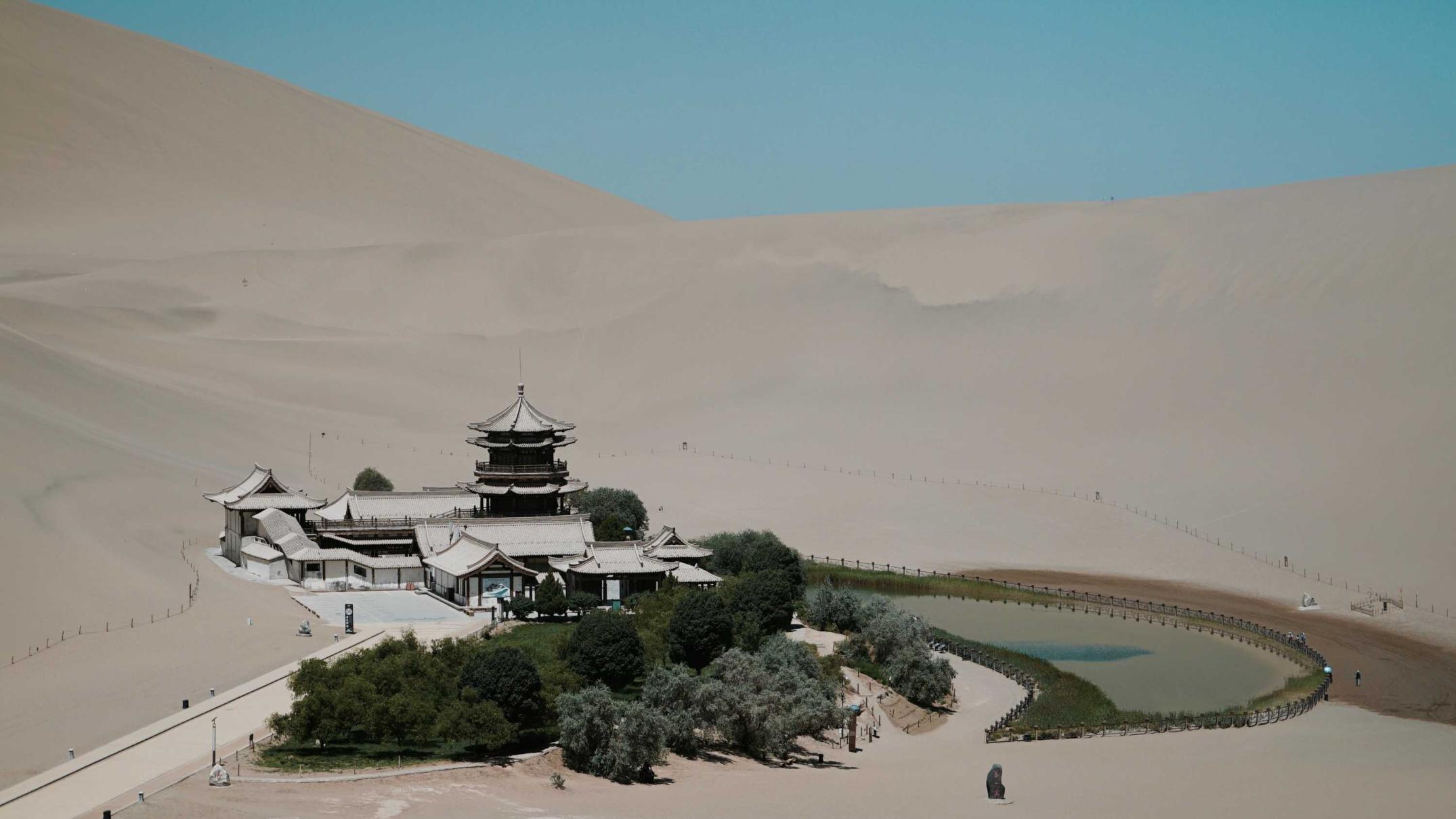It looks like you're using an Ad Blocker.
Please white-list or disable AboveTopSecret.com in your ad-blocking tool.
Thank you.
Some features of ATS will be disabled while you continue to use an ad-blocker.
7
share:
www.abc.net.au...
Just sayin' ...
"frogs in pond , do you copy , over"
Deep in the Himalayas sits a remote research station that is
tracking an alarming trend in climate change, with implications
that could disrupt the lives of more than 1 billion people and pitch
the most populated region of the world into chaos. The station lies
in the heart of a region called the Third Pole, an area that contains
the largest area of frozen water outside of the North Pole and South
Pole.
Despite its relative anonymity, the Third Pole is vitally important;
it is the source of Asia's 10 largest rivers including the Yellow, the
Yangzi, the Mekong, the Irrawaddy and the Ganges — and their fertile
deltas. The station was the first one to open in China, in 1958, so it
has a long history of collecting data. Because of its size, altitude and
the amount of water it holds, the Third Pole is a major engine of global
weather. Professor Qin has been in charge of the Tiger Valley station
since 2005. He says the team's research shows the glacier melt is
happening much faster than anticipated. In Tiger Valley the melt is
fast, furious and constant: water just keeps pouring out of the
10-kilometre glacier.the rate of melting has almost doubled in the
past decade.
Based on the figures from 1960 to 2005, in that 45 years,
it only retreated by 260 metres. But in [the most] recent 10 years it
retreated by 140 metres, He says the reason for the great melt is
that the temperature has been increasing at a much faster rate up
in the Qinghai Tibetan Plateau.
Dunghuang in north-western China.
From the data we had over 50 years,
it showed in our research areas the temperature increased by
1.5 degrees Celsius — it is much higher than the national temperature
increase," he says. It is because, in the high altitude areas, the
temperature is sensitive to the global warming. But the scientists are
discovering another factor that is causing the big melt: pollution from
vehicle exhaust and coal burners is now making its way up to the region.
Black carbon particles and dust land on the glaciers and absorb the sun
and heat, unlike the white ice that reflects it.
Just sayin' ...
"frogs in pond , do you copy , over"
edit on 7-8-2016 by radarloveguy because: xxx
edit on 7-8-2016 by radarloveguy because: (no reason
given)
edit on 7-8-2016 by radarloveguy because: (no reason given)
Where do you think these polar blasts the USA has been getting that is causing everyone to say 'Global warming my A$@#' are coming from? The 2 major
poles are melting as well and they are sending blasts of cold air in the direction of the equator aka the 'wandering jetstream'
Al Gore predicted every last bit of this in 'An inconvenient truth' But because it is Al Gore and because people are not seeing the desert sands blowing on their doorsteps they are like ostriches with their heads in the sand.
Al Gore predicted every last bit of this in 'An inconvenient truth' But because it is Al Gore and because people are not seeing the desert sands blowing on their doorsteps they are like ostriches with their heads in the sand.
Send in the Army Corp of Engineers, they can fix it. Cover the ice caps with tin foil, put a dam here, a course diversion there, make that part into a
cement lined ditch, have it empty into a pond and problem solved.
The Tibetan Plateau is indeed melting, and it is indeed a major problem climatologically.
But it's not the boogeyman called carbon dioxide doing it.
The Tibetan Plateau has an average elevation approaching 15,000 feet above sea level. That's almost three miles. The air is barely dense enough to breathe, and it is bitter cold. Little lives there, including carbon dioxide.
Carbon dioxide has a density of 1.977 g/L, compared to 1.251 g/L for nitrogen and 1.429 g/L for oxygen. It rises like a lead balloon. Were it not for weather patterns, our atmosphere would exist as a tiny layer of carbon dioxide at the surface, followed by a pure layer of oxygen, topped off by a huge layer of nitrogen (with other minor component layers sandwiched in).
We do have weather patterns mixing the air (thankfully), but not so much to push heavier gases to the very top and lighter gasses to the very bottom. The amount of carbon dioxide in the Tibetan Plateau is all but nonexistent.
The amount of smog is another thing.
This is precisely why I argue so vehemently against Global Warming. There is a clear implication in the article that carbon dioxide from man's activities is melting the ice on the Tibetan Plateau. There is also an explanation that hot exhaust from actual pollution is transporting soot high enough to melt the glaciers. But which will people latch onto as the "Oh, my God" issue?
Carbon dioxide. I guarantee in a future climate thread this phenomenon will be espoused as absolute proof of the evils of carbon dioxide.
In the meantime, while politicians and bankers continue to press forward in their attempt to tax breathing, the glacier will continue to melt because that tax is more important than fixing the real problem.
And the people will cheer.
Disgusting.
TheRedneck
But it's not the boogeyman called carbon dioxide doing it.
The Tibetan Plateau has an average elevation approaching 15,000 feet above sea level. That's almost three miles. The air is barely dense enough to breathe, and it is bitter cold. Little lives there, including carbon dioxide.
Carbon dioxide has a density of 1.977 g/L, compared to 1.251 g/L for nitrogen and 1.429 g/L for oxygen. It rises like a lead balloon. Were it not for weather patterns, our atmosphere would exist as a tiny layer of carbon dioxide at the surface, followed by a pure layer of oxygen, topped off by a huge layer of nitrogen (with other minor component layers sandwiched in).
We do have weather patterns mixing the air (thankfully), but not so much to push heavier gases to the very top and lighter gasses to the very bottom. The amount of carbon dioxide in the Tibetan Plateau is all but nonexistent.
The amount of smog is another thing.
The original source
But the scientists are discovering another factor that is causing the big melt: pollution from vehicle exhaust and coal burners is now making its way up to the region. Black carbon particles and dust land on the glaciers and absorb the sun and heat, unlike the white ice that reflects it.
This is precisely why I argue so vehemently against Global Warming. There is a clear implication in the article that carbon dioxide from man's activities is melting the ice on the Tibetan Plateau. There is also an explanation that hot exhaust from actual pollution is transporting soot high enough to melt the glaciers. But which will people latch onto as the "Oh, my God" issue?
Carbon dioxide. I guarantee in a future climate thread this phenomenon will be espoused as absolute proof of the evils of carbon dioxide.
In the meantime, while politicians and bankers continue to press forward in their attempt to tax breathing, the glacier will continue to melt because that tax is more important than fixing the real problem.
And the people will cheer.
Disgusting.
TheRedneck
a reply to: TheRedneck
If I get this right, redneck, you think because CO2 is not present in overwhelming quantities at higher elevations that it has no effect on 'blanketing' at those elevations. That CO2 is a lesser component at altitudes of 15,000 feet or more.
Since the atmosphere IS continuously mixed, where did you get the impression that the CO2 levels are less in the Himalayas?
If the lower altitude temps increase would they not affect the higher ones due to mixing? Wouldn't mixing become more relevant with higher temps as the gas expands and increases the sphere of mixing?
Disgusting!
ruc.noaa.gov...
Read the 'Abstract' paragraph and delete your BS, thanks.
If I get this right, redneck, you think because CO2 is not present in overwhelming quantities at higher elevations that it has no effect on 'blanketing' at those elevations. That CO2 is a lesser component at altitudes of 15,000 feet or more.
Since the atmosphere IS continuously mixed, where did you get the impression that the CO2 levels are less in the Himalayas?
If the lower altitude temps increase would they not affect the higher ones due to mixing? Wouldn't mixing become more relevant with higher temps as the gas expands and increases the sphere of mixing?
Disgusting!
ruc.noaa.gov...
Read the 'Abstract' paragraph and delete your BS, thanks.
1.
originally posted by: TheRedneck
2.
There is a clear implication in the article that carbon dioxide from man's activities is melting the ice on the Tibetan Plateau.
There is also an explanation that hot exhaust from actual pollution is transporting soot high enough to melt the glaciers.
But which will people latch onto as the "Oh, my God" issue?
Carbon dioxide. I guarantee in a future climate thread this phenomenon will be espoused as absolute proof of the evils of carbon dioxide.
In the meantime, while politicians and bankers continue to press forward in their attempt to tax breathing, the glacier will continue to melt because that tax is more important than fixing the real problem.
Disgusting.
FYI - I've 'bolded' and numbered the two points in your post for clarity in my reply...
Here's the thing:
You obviously understand that (point 2) "exhaust from actual pollution" is causing serious environmental damage, a "real problem" in need of "fixing" -
- Yet, you believe that (point 1) "carbon dioxide from man's activities" is 'not' an issue (except to "politicians and bankers")
Do you not see the failure in logic here?
It is "man's activities" (fossil fuel burning) that 'causes' all the "exhaust from actual pollution"!
In fact, all of that actual pollution comes from the same "activities" that carbon dioxide comes from...
...so, even 'if' CO2 wasn't an issue, the 'thing' that needs "fixing" -
"the real problem", is the exact same 'thing' - the burning of fossil fuels!!
Do you not see the way you have been played?
'They' have you fighting against the very 'thing' you know to be the solution to a very "real problem".
Glaciers are melting and our planet's ecosystems are in danger because of 'pollution' that comes from burning fossil fuels...
...and the guys who run those industries have done such a great job 'distracting' everyone from the "real problem" -
- people are so busy screaming about CO2 taxes that they aren't even looking at how badly we need the 'real solutions'...
...clean energy sources
(as well as every individual taking responsibility for reducing their personal pollution 'footprint')*
*My husband and I both drive Prius's, and we took out a second mortgage in order to install solar electricity...
edit on 7-8-2016 by lostgirl because: (no reason given)
a reply to: largo
Carbon dioxide is not present in overwhelming quantities at any altitude on Earth. Nitrogen and oxygen are, and argon comes in a distant third.
I tried to read the paper you posted, but I started laughing so hard I couldn't see through the tears. The sheer number of assertions made to establish the mathematical basis is ludicrous, when all one needs to do is measure the pressure and various gas concentrations.
The first, best, and most ludicrous of these was the assumption that atmospheric chaotic disturbances (generally restricted to the troposphere) are sufficient to offset 50% or so differences in density well, well past the troposphere. He didn't even guantify how this miracle happens. According to that assumption, we should be able to raise the Titanic by stirring the ocean.
Maybe they have done so and I just haven't heard about it. Show me how someone has raised a metal ship by stirring the water and I will gladly "delete my BS." I simply ask that you prove to me it is BS first. Proof does not include reports which fly in the face of accepted physics.
If you were to actually measure the atmospheric conditions are 15,000 feet, instead of trying to calculate it based on wild assumptions, you would find that the atmospheric pressure is lower; the atmospheric density is lower; there is a somewhat higher concentration of nitrogen vs. other gases, and a substantially lower concentration of carbon dioxide (substantially, due to it's rarity in the atmosphere overall). That prediction is based on centuries of knowledge of buoyancy and extensive measurements of pressure at various altitudes.
I hope the author was well paid for putting his name to that rubbish.
TheRedneck
Carbon dioxide is not present in overwhelming quantities at any altitude on Earth. Nitrogen and oxygen are, and argon comes in a distant third.
I tried to read the paper you posted, but I started laughing so hard I couldn't see through the tears. The sheer number of assertions made to establish the mathematical basis is ludicrous, when all one needs to do is measure the pressure and various gas concentrations.
The first, best, and most ludicrous of these was the assumption that atmospheric chaotic disturbances (generally restricted to the troposphere) are sufficient to offset 50% or so differences in density well, well past the troposphere. He didn't even guantify how this miracle happens. According to that assumption, we should be able to raise the Titanic by stirring the ocean.
Maybe they have done so and I just haven't heard about it. Show me how someone has raised a metal ship by stirring the water and I will gladly "delete my BS." I simply ask that you prove to me it is BS first. Proof does not include reports which fly in the face of accepted physics.
If you were to actually measure the atmospheric conditions are 15,000 feet, instead of trying to calculate it based on wild assumptions, you would find that the atmospheric pressure is lower; the atmospheric density is lower; there is a somewhat higher concentration of nitrogen vs. other gases, and a substantially lower concentration of carbon dioxide (substantially, due to it's rarity in the atmosphere overall). That prediction is based on centuries of knowledge of buoyancy and extensive measurements of pressure at various altitudes.
I hope the author was well paid for putting his name to that rubbish.
TheRedneck
a reply to: lostgirl
It seems you did not get my point. Soot and smog is not carbon dioxide. Soot and smog can be cleaned from exhaust, indeed, have been being cleaned from exhaust for quite some time. Carbon dioxide can be scrubbed as well, but this has become possible only recently and has been scoffed at as a solution to pollution.
But instead of cleaning the exhaust, the powers that be seem intent to tax. I'm not sure how this is supposed to work; the last time I checked, paying someone money had little effect on chemical reactions.
That is my concern, hopefully clearer now. We should raise the red flag on the soot that is melting the ice. We should clean the exhausts that produce it. We do not have to tax every person earth to do that, or even to improve the effectiveness of the cleaning process.
If my house is dirty, I clean it. I guess some people go shopping?
Congratulations on your investments. I hope they serve you well.
TheRedneck
It seems you did not get my point. Soot and smog is not carbon dioxide. Soot and smog can be cleaned from exhaust, indeed, have been being cleaned from exhaust for quite some time. Carbon dioxide can be scrubbed as well, but this has become possible only recently and has been scoffed at as a solution to pollution.
But instead of cleaning the exhaust, the powers that be seem intent to tax. I'm not sure how this is supposed to work; the last time I checked, paying someone money had little effect on chemical reactions.
That is my concern, hopefully clearer now. We should raise the red flag on the soot that is melting the ice. We should clean the exhausts that produce it. We do not have to tax every person earth to do that, or even to improve the effectiveness of the cleaning process.
If my house is dirty, I clean it. I guess some people go shopping?
Congratulations on your investments. I hope they serve you well.
TheRedneck
a reply to: TheRedneck
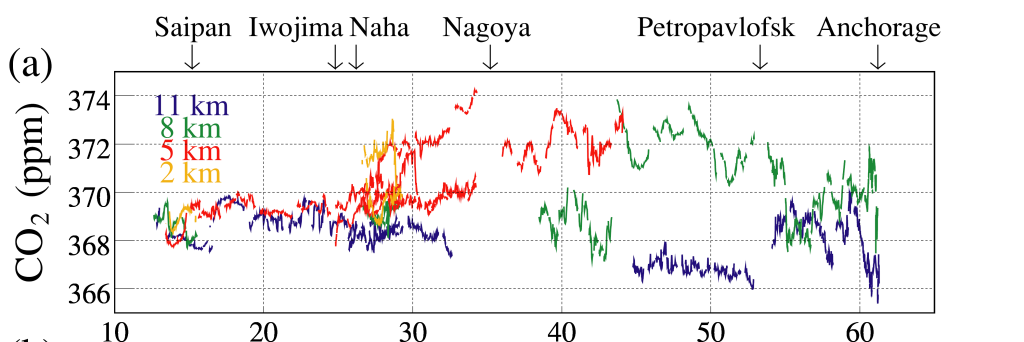 www.tellusb.net...
www.tellusb.net...
The CO2 sensor on Mauna Loa is at an elevation of 11,000 feet. It is currently recording over 400 ppm. At what altitude do you reckon it goes from 400 to 0 ppm?
airs.jpl.nasa.gov...
Also to be considered, convection brings warmer air upward.
You base this statement upon what data? In situ measurements from 2000 (seems quite in line with Mauna Kea records). Doesn't seem to be much of a difference in the troposphere.
The amount of carbon dioxide in the Tibetan Plateau is all but nonexistent.

The CO2 sensor on Mauna Loa is at an elevation of 11,000 feet. It is currently recording over 400 ppm. At what altitude do you reckon it goes from 400 to 0 ppm?
In 2002, AIRS--which collects data around the entire globe every day--reported the average concentration of carbon dioxide in Earth's mid-troposphere to be 372 parts per million (ppm). Still going strong in 2013, AIRS reported April's average daily global concentration in this region to be 397 ppm, with peaks exceeding 400 ppm.
airs.jpl.nasa.gov...
Also to be considered, convection brings warmer air upward.
I haven't seen a lot in the US about carbon taxes but is it not true that higher prices tend to affect demand?
But instead of cleaning the exhaust, the powers that be seem intent to tax. I'm not sure how this is supposed to work; the last time I checked, paying someone money had little effect on chemical reactions.
Is that soot also causing higher air temperatures in the Arctic? Increased ocean heat content?
We should raise the red flag on the soot that is melting the ice.
edit on 8/7/2016 by Phage because: (no reason given)
a reply to: Phage
Thank you, Phage, for a good example of a scientific paper. It made for an interesting read so far.
I am on my tablet, so embedding is difficult at the moment; I refer you to Figure 3a, the carbon dioxide concentrations at various altitudes and positions. While the data is more sketchy than optimal, it appears to me there is enough to make some conclusions.
I should mention here, for the benefit of readers, that an altitude of about 5 miles is roughly equivalent to 8 km.
The concentrations are given at 2, 5, 8, and 11 km altitude. The mean averages between these different altitudes at the same geographic locations indicate a decline with altitude in carbon dioxide concentrations. I am somewhat surprised by the amount of decline, admittedly, but the fact that there is indeed a decline consistent with gualitative expectations gives me some measure of confidence in the data.
Also surprising is the variation between geographic locations. That is more than I suspected, and probably warrants further study.
You should know by now that I refuse to put much faith in a sensor sitting atop a substantial, natural carbon dioxide source. Regardless of the adjustments made to the data to compensate, or actually due to those necessary adjustments, I cannot have any faith in those reports. Another example of ludicrous attempts to skew observational data.
As for when the concentration approaches zero... much farther up. The gasses are very hot coming from a volcano and will therefore exhibit lower densities. The levels, due to the chaotic atmospheric mixing, will also exhibit a Gaussian concentration. Combined, these two facts indicate the area above Mauna Loa should show indications of higher-than-normal concentrations for quite some distance, possibly beyond the troposphere.
The politically-charged terms such as "cap-and-trade" or "carbon tax" have not been widely used as of late. The concepts associated with them are still alive and well, however. There have been no alternate strategies proposed to combat the evil demon called carbon dioxide.
Price affects demand, yes, but in inverse proportion to the necessity of purchase. If an item is a luxury, that relationship is magnified; if that item is a necessity it is minimalized. Health care is a perfect example. I know of no one who checks their budget or shops around for prices during a heart attack. A boat, however, is a luxury and customers regularly compare prices or even decline to purchase one due to price.
To take an extreme example, taxes are the ultimate necessity. Does the price of taxes affect the fact that people have to pay them?
Energy is a necessity, if one wishes to not freeze to death during the winter or live a caveman-style life.
Nice deflection attempt, Phage. Sorry, but I'm not biting. Until you can demonstrate a causal relationship between the conditions you mention and the Tibetan Plateau, those conditions are not a consideration.
I will quickly say that you, yourself, in a previous thread, alerted me to what I believe is the most probable cause of increasing Arctic temperatures; a warming of the Bering Current. There seems to be a possible connection between that phenomenon and the frequency of South Pacific earthquakes/volcanic eruptions, but I have not had time to complete that analysis.
Back on topic, you did read where the scientists themselves blamed soot deposits for the increasing melt, correct?
TheRedneck
Thank you, Phage, for a good example of a scientific paper. It made for an interesting read so far.
I am on my tablet, so embedding is difficult at the moment; I refer you to Figure 3a, the carbon dioxide concentrations at various altitudes and positions. While the data is more sketchy than optimal, it appears to me there is enough to make some conclusions.
I should mention here, for the benefit of readers, that an altitude of about 5 miles is roughly equivalent to 8 km.
The concentrations are given at 2, 5, 8, and 11 km altitude. The mean averages between these different altitudes at the same geographic locations indicate a decline with altitude in carbon dioxide concentrations. I am somewhat surprised by the amount of decline, admittedly, but the fact that there is indeed a decline consistent with gualitative expectations gives me some measure of confidence in the data.
Also surprising is the variation between geographic locations. That is more than I suspected, and probably warrants further study.
The CO2 sensor on Mauna Loa is at an elevation of 11,000 feet. It is currently recording over 400 ppm. At what altitude do you reckon it goes from 400 to 0 ppm?
You should know by now that I refuse to put much faith in a sensor sitting atop a substantial, natural carbon dioxide source. Regardless of the adjustments made to the data to compensate, or actually due to those necessary adjustments, I cannot have any faith in those reports. Another example of ludicrous attempts to skew observational data.
As for when the concentration approaches zero... much farther up. The gasses are very hot coming from a volcano and will therefore exhibit lower densities. The levels, due to the chaotic atmospheric mixing, will also exhibit a Gaussian concentration. Combined, these two facts indicate the area above Mauna Loa should show indications of higher-than-normal concentrations for quite some distance, possibly beyond the troposphere.
I haven't seen a lot in the US about carbon taxes but is it not true that higher prices tend to affect demand?
The politically-charged terms such as "cap-and-trade" or "carbon tax" have not been widely used as of late. The concepts associated with them are still alive and well, however. There have been no alternate strategies proposed to combat the evil demon called carbon dioxide.
Price affects demand, yes, but in inverse proportion to the necessity of purchase. If an item is a luxury, that relationship is magnified; if that item is a necessity it is minimalized. Health care is a perfect example. I know of no one who checks their budget or shops around for prices during a heart attack. A boat, however, is a luxury and customers regularly compare prices or even decline to purchase one due to price.
To take an extreme example, taxes are the ultimate necessity. Does the price of taxes affect the fact that people have to pay them?
Energy is a necessity, if one wishes to not freeze to death during the winter or live a caveman-style life.
Is that soot also causing higher air temperatures in the Arctic? Increased ocean heat content?
Nice deflection attempt, Phage. Sorry, but I'm not biting. Until you can demonstrate a causal relationship between the conditions you mention and the Tibetan Plateau, those conditions are not a consideration.
I will quickly say that you, yourself, in a previous thread, alerted me to what I believe is the most probable cause of increasing Arctic temperatures; a warming of the Bering Current. There seems to be a possible connection between that phenomenon and the frequency of South Pacific earthquakes/volcanic eruptions, but I have not had time to complete that analysis.
Back on topic, you did read where the scientists themselves blamed soot deposits for the increasing melt, correct?
TheRedneck
a reply to: TheRedneck
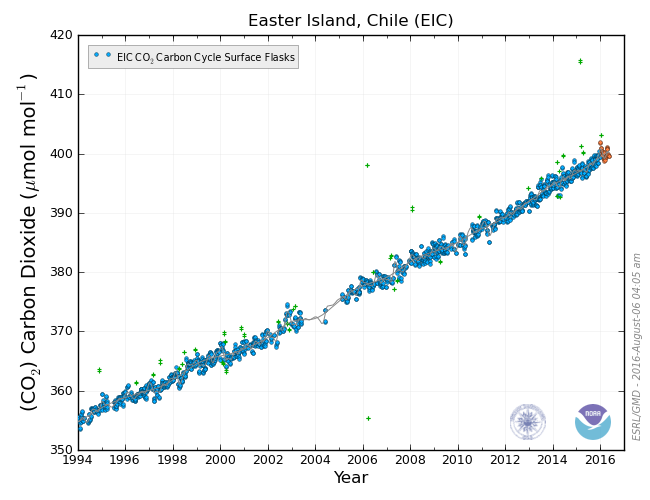
www.esrl.noaa.gov...
Note that the locations are are at different latitudes, given at the bottom of the chart. The height of the tropopause varies with latitude and yes, there is a decline in CO2 levels (not a great decline) above the tropopause. Certainly not non existent, as you claimed.
Also surprising is the variation between geographic locations. That is more than I suspected, and probably warrants further study.
I've noticed that you refuse to put much faith in data which does not conform to your views. Until the mid 1980s Kilauea was not in an eruptive phase, I see no spiking of CO2 concentrations when that changed. Never mind the fact that the Mauna Loa levels are consistent with levels found elsewhere. Easter Island, for example.
You should know by now that I refuse to put much faith in a sensor sitting atop a substantial, natural carbon dioxide source.

www.esrl.noaa.gov...
Or perhaps the ocean is getting warmer because the atmosphere is.
There seems to be a possible connection between that phenomenon and the frequency of South Pacific earthquakes/volcanic eruptions, but I have not had time to complete that analysis.
edit on 8/8/2016 by Phage because: (no reason given)
new topics
-
Where should Trump hold his next rally
2024 Elections: 1 hours ago -
Shocking Number of Voters are Open to Committing Election Fraud
US Political Madness: 2 hours ago -
Gov Kristi Noem Shot and Killed "Less Than Worthless Dog" and a 'Smelly Goat
2024 Elections: 3 hours ago -
Falkville Robot-Man
Aliens and UFOs: 3 hours ago -
James O’Keefe: I have evidence that exposes the CIA, and it’s on camera.
Whistle Blowers and Leaked Documents: 4 hours ago -
Australian PM says the quiet part out loud - "free speech is a threat to democratic dicourse"...?!
New World Order: 4 hours ago -
Ireland VS Globalists
Social Issues and Civil Unrest: 5 hours ago -
Biden "Happy To Debate Trump"
2024 Elections: 5 hours ago -
RAAF airbase in Roswell, New Mexico is on fire
Aliens and UFOs: 6 hours ago -
What is the white pill?
Philosophy and Metaphysics: 7 hours ago
top topics
-
A Warning to America: 25 Ways the US is Being Destroyed
New World Order: 15 hours ago, 21 flags -
Blast from the past: ATS Review Podcast, 2006: With All Three Amigos
Member PODcasts: 8 hours ago, 11 flags -
James O’Keefe: I have evidence that exposes the CIA, and it’s on camera.
Whistle Blowers and Leaked Documents: 4 hours ago, 10 flags -
Biden "Happy To Debate Trump"
2024 Elections: 5 hours ago, 10 flags -
Australian PM says the quiet part out loud - "free speech is a threat to democratic dicourse"...?!
New World Order: 4 hours ago, 9 flags -
Mike Pinder The Moody Blues R.I.P.
Music: 8 hours ago, 8 flags -
What is the white pill?
Philosophy and Metaphysics: 7 hours ago, 5 flags -
RAAF airbase in Roswell, New Mexico is on fire
Aliens and UFOs: 6 hours ago, 5 flags -
Ireland VS Globalists
Social Issues and Civil Unrest: 5 hours ago, 4 flags -
Putin, Russia and the Great Architects of the Universe
ATS Skunk Works: 11 hours ago, 4 flags
active topics
-
President BIDEN's FBI Raided Donald Trump's Florida Home for OBAMA-NORTH KOREA Documents.
Political Conspiracies • 34 • : AwakeNotWoke -
The Acronym Game .. Pt.3
General Chit Chat • 7756 • : bally001 -
RAAF airbase in Roswell, New Mexico is on fire
Aliens and UFOs • 8 • : Skinnerbot -
Putin, Russia and the Great Architects of the Universe
ATS Skunk Works • 27 • : KnowItAllKnowNothin -
Falkville Robot-Man
Aliens and UFOs • 5 • : Ophiuchus1 -
Biden "Happy To Debate Trump"
2024 Elections • 42 • : JadedGhost -
Gold and silver prices....woo hoo
History • 86 • : lilzazz -
Mood Music Part VI
Music • 3110 • : TheDiscoKing -
University of Texas Instantly Shuts Down Anti Israel Protests
Education and Media • 308 • : cherokeetroy -
Meadows, Giuliani Among 11 Indicted in Arizona in Latest 2020 Election Subversion Case
Mainstream News • 29 • : Threadbarer
7

